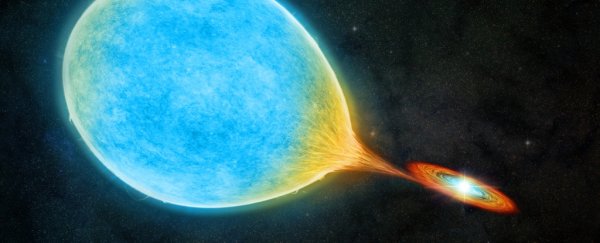Astronomers have finally observed the satisfying solution to a perplexing cosmic problem: the apparent mystery of stars that are basically too small to exist.
White dwarfs that are considered to be too tiny to exist in the current lifetime of the Universe have now, however, been spotted having their mass slurped off by binary companions – a mechanism long suspected that might explain their size, but never before proven in the wild.
These 'missing link' binaries are called evolved cataclysmic variables, and their discovery helps us understand one of the stages on the evolutionary path of dead stars.
"We have observed the first physical proof of a new population of transitional binary stars," says astronomer Kareem El-Badry of the Harvard & Smithsonian Center for Astrophysics.
"This is exciting; it's a missing evolutionary link in binary star formation models that we've been looking for."
White dwarfs are what becomes of a star less than about eight times the mass of the Sun when it runs out of fuel for the process of nuclear fusion.
The dying star ejects most of its mass, and the core collapses down into an extremely dense object – up to about 1.4 times the mass of the Sun, packed into a sphere around the size of Earth (although they can vary).
On rare occasions, however, they can be so low in mass that, according to our models of stellar evolution, they shouldn't exist. These extremely low-mass white dwarfs, or ELMs, are only around one-third of the mass of the Sun. Such mass loss should take far longer than the current lifetime of the Universe, which is only around 13.8 billion years.
But that's only if the star exists in isolation. If something else – such as a binary companion – were to slurp mass off the white dwarf, that would speed the process significantly, neatly explaining the presence of ELMs in the Universe. The only problem that remained, until now, is that the process had never been observed.
According to theory, the process should take place after a stage called the cataclysmic variable stage. This is when a white dwarf is in a binary system with another star, so close together that the white dwarf is accreting material from its companion.
Periodically, the white dwarf will erupt as the accreted material triggers runaway hydrogen fusion in its atmosphere. These cataclysms cause variations in brightness, hence the name.
Sometimes, a white dwarf star will accrete so much material that it will become unstable, exploding in a Type Ia supernova – but there's another option too. The balance can tip so that the other star starts stealing mass from the white dwarf instead.
El-Badry and his colleagues used data from astronomical surveys from the Gaia space observatory and the Zwicky transient facility, picking out 50 stars that could be in this intermediate stage. Then they used the Shane Telescope at Lick Observatory to obtain detailed observations of 21 of these binaries.
They hit gold.
"100 percent of the candidates were these pre-ELMs we'd been looking for. They were more puffed up and bloated than ELMs. They also were egg-shaped because the gravitational pull of the other star distorts their spherical shape," El-Badry says.
"We found the evolutionary link between two classes of binary stars – cataclysmic variables and ELM white dwarfs – and we found a decent number of them."
Most of the binaries consisted of a white dwarf around 0.15 times the mass of the Sun, with companions around 0.8 times the mass of the Sun.
All of the white dwarfs showed signs of mass loss to their companion stars; for 13 of the stars, the process was still ongoing, while the remaining eight were no longer losing mass, but were puffy, as though mass loss was recent. All 21 of the stars were hotter and brighter than usually seen in a cataclysmic variable white dwarf.
More work is needed in order to fully understand the population of evolved cataclysmic variables, including more detailed observations of the 21 binaries. The team also hopes to go back and take a closer look at the other 29 binaries from the initial 50 candidates.
The team's research has been published in the Monthly Notices of the Royal Astronomical Society.
